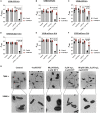The Assessment on Synergistic Activity of Ebselen and Silver Ion Against Yersinia pseudotuberculosis
- PMID: 35958130
- PMCID: PMC9363147
- DOI: 10.3389/fmicb.2022.963901
The Assessment on Synergistic Activity of Ebselen and Silver Ion Against Yersinia pseudotuberculosis
Abstract
Yersinia pseudotuberculosis is a foodborne zoonotic bacterium that is pathogenic to guinea pigs, rabbits, and mice. It also causes pseudotuberculosis in humans. However, it still lacked the scientific basis for control. Here, we found out that Ebselen (EbSe) exhibited synergistic antibacterial activity with silver nitrate (Ag+) against Y. pseudotuberculosis YpIII strain with high efficacy in vitro using UV-visible light absorption spectrum, 5,5'-dithiobis-(2-nitrobenzoic acid), laser scanning confocal microscope, flow cytometry, transmission electron microscopy and Western blotting assays. The depletion of total glutathione (GSH) amount and inhibition of thioredoxin reductase (TrxR) activity in thiol-dependent redox system revealed the destructiveness of EbSe-Ag+-caused intracellular oxidative stress. Furthermore, a YpIII-caused mice gastroenteritis model was constructed. EbSe-Ag+ significantly reduced bacterial loads with low toxicity. It also down-regulated the expression levels of interferon (IL)-1β and tumor necrosis factor-α, up-regulated the expression level of IL-10 on-site. All the in vivo results demonstrated the antibacterial activity and immune-modulatory property of EbSe-Ag+. Collectively, these results provided academic fundament for further analysis and development of EbSe-Ag+ as the antibacterial agents for pseudotuberculosis control.
Keywords: Ebselen; Yersinia pseudotuberculosis; antibacterial activity; immune-modulatory property; silver nitrate.
Copyright © 2022 Dong, Chen, Zou, Liu, Deng, Guo, Wang, Chen, Wang and Wang.
Conflict of interest statement
The authors declare that the research was conducted in the absence of any commercial or financial relationships that could be construed as a potential conflict of interest.
Figures












References
-
- Bakholdina S. I., Shubin F. N., Solov’eva T. F. (2009). [Oxygen deficiency increases invasive activity and resistance of Yersinia pseudotuberculosis to heat stress]. Zh. Mikrobiol. Epidemiol. Immunobiol. 3 18–23. - PubMed
LinkOut - more resources
Full Text Sources

